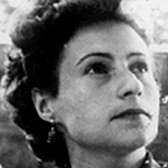
-
Learn More about Susan
Susan was born Susanne Strauss on January 9, 1926 in Vacha, Germany, a small Thuringian town where her mother’s family had lived for more than 400 years. Her father, Hermann, owned a general store and her mother, Bertha, managed the home and took care of Susan and her younger sister, Brunhilde (b. 1928). The Strauss family was one of about twenty Jewish families living in Vacha in the years leading up to the war.
Soon after the Nazis took power, many of Susan's friends stopped playing with her. In 1938 she was forced to leave the public school and she and Brunhilde moved to Frankfurt am Main to study at the Jewish school. That November, the Nazis unleashed a wave of antisemitic violence throughout Germany known as Kristallnacht, “The Night of Broken Glass.” In Vacha, local party members damaged the family store. Her father was arrested and imprisoned in Buchenwald. He was released four weeks later on the condition that he would emigrate quickly; he fled to Belgium in 1939. Nearly a year later, in February 1940, her father reached the United States, but he was unable to get his family out of Germany.
After Susan’s father emigrated, the family moved to Berlin with Hermann’s mother, Jettchen. Susan, her mother, and sister were conscripted into forced labor and were put to work producing radio equipment for German U-boats. On January 25, 1942, Susan and her family were deported to the Riga ghetto in occupied Latvia. Shortly after arriving, her grandmother, Jettchen, was taken to the nearby forest and killed. The ghetto was liquidated in fall 1943 and Susan and her family were transferred to the nearby Kaiserwald concentration camp. After arriving, Susan was separated from her mother and sister and sent to perform forced labor at the Meteor factory where she repaired and painted pontoon boats. In August 1944, the camp was evacuated and she was transported by boat to Stutthof concentration camp, only to be transferred to the subcamp of Sophienwalde two weeks later. At Sophienwalde she was forced to uproot trees to clear the way for a new road and later worked as a bricklayer. In February 1945 the camp was evacuated and Susan and the other prisoners were forced on a death march.
Susan’s mother died in Thorn (Toruń), a subcamp of Stutthof and her sister, Brunhilde, died in Stutthof or on a death march. Susan was liberated by Soviet troops on March 10, 1945 in the town of Chynowie. With nowhere to go, she remained with the Soviets who sent her away from the front and forced her to work on a farm. Eventually she was sent to work in the town of Koszalin where she met a Polish Jewish survivor from Łódź named Herman Taube.
Susan and Herman married in July 1945 and lived briefly in Poland until the July 1946 pogrom in Kielce made it apparent that they were no longer safe there. They made their way back to Germany, living for a time in a displaced persons camp before settling in the town of Alsfeld. In April 1947 Susan and Herman immigrated to the United States where they were reunited with her father and settled in Baltimore. The Taubes had five children.
Why I Volunteer
I like to volunteer to meet nice kids and work with nice people. Sitting at the donor desk I try and help the museum and I am able to speak about my experiences.




